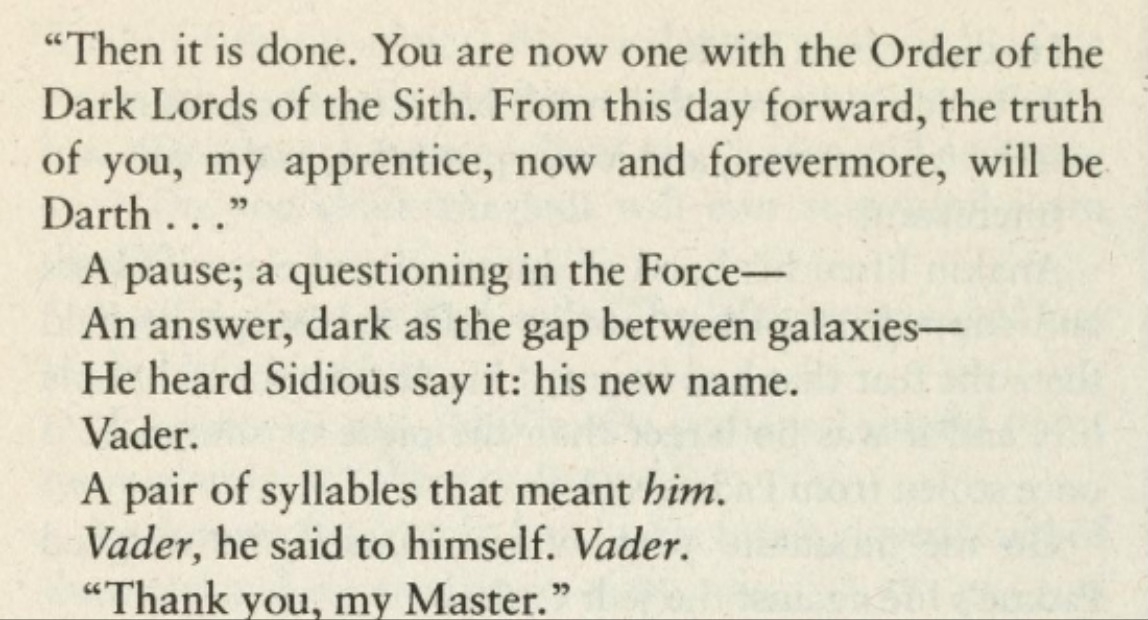When Darth Bane chose his apprentice Zannah, he allowed her to embrace her new identity on her own terms. A thousand years later, Darth Sidious didn’t offer Anakin that same freedom – he named him Darth Vader. So why the difference? Let’s break it down.
Sith Traditions Evolved – and the Naming Ritual Did Too
In Bane’s time, Sith naming was partly a ritual of identity. It was symbolic – a way to cast off your past and embrace your place in the Rule of Two. Zannah, born as Rain, rejected her old nickname and reclaimed her birth name, becoming Darth Zannah. It was her choice, and it meant something.
By the time of Sidious, though, Sith customs had shifted. According to Darth Plagueis, Sith names often came through dark side communion – masters would meditate and receive guidance from the Force. That’s how Plagueis named Sidious.
This moment is revealed in Darth Plagueis, when Plagueis watches the young Palpatine with calculating judgment and says:
“You’re heartless, ambitious, arrogant, insidious, and without shame or empathy. More, you’re a murderer.”
… “You are not the only being in this plush stateroom with the power to kill.”

Palpatine, in turn, embraces the Sith path with chilling certainty:
“It is my will to join my destiny forever with the Order of the Sith Lords.”
Plagueis touches him on the crown and says:
“Then it is done. From this day forward, the truth of you, now and forever more, will be Sidious.”

This was not a name Palpatine chose—it was a title conferred by his master, so when Sidious named Vader, he wasn’t just being controlling; he was following what had become a new norm (told in Revenge of the Sith novelization). It was the master’s right – and sometimes even their spiritual duty – to give the name.
“Kneel before me, Anakin Skywalker.”
Anakin dropped to one knee. He lowered his head.
“It is your will to join your destiny forever with the Order of the Sith Lords?”
There was no hesitation. “Yes.”
Darth Sidious laid a pale hand on Anakin’s brow.

And with the same solemnity, he declared:
“Then it is done. You are now one with the Order of the Dark Lords of the Sith. From this day forward, the truth of you, my apprentice, now and forevermore, will be Darth…”
A pause; a questioning in the Force—
An answer, dark as the gap between galaxies—
He heard Sidious say it: his new name.
Vader.
A pair of syllables that meant him.

Palpatine Used the Name “Darth Vader” to Show Ownership
When Sidious named Anakin “Darth Vader,” it wasn’t just about giving him a cool Sith title – it was about control. From the very beginning, Palpatine had been pulling Anakin’s strings. Naming him was one more way to assert dominance. Instead of letting Anakin shape his new persona, Sidious imposed it, reinforcing the message: “You are mine.”
This power dynamic shows up everywhere. Sidious didn’t just name Anakin. He designed his armor. He rebuilt his body. Even after Mustafar, when Vader was at his lowest, Sidious used that moment to remind him who was in charge. In the Darth Vader comics, Sidious threatens Vader’s life not long after saving it. That’s not mentorship – that’s control.
Zannah Chose the Dark Side Freely. Anakin Was Manipulated
Zannah’s journey was about acceptance. After surviving tragedy on Ruusan, she embraced the dark side on her own terms. She didn’t stumble into it – she committed. Her name reflected that choice. Even Darth Bane, who was ruthless in every way, allowed her to claim that identity because he believed in strengthening the apprentice.
Anakin’s story is different. He didn’t walk into the dark with clarity – he was broken, desperate, and emotionally manipulated. Sidious preyed on his fears about Padmé and the Jedi. By the time Anakin fell, he had been pushed into a corner. Giving him the name “Vader” was Sidious’s way of saying, “You belong to me now. You don’t even get to choose who you are.”
Palpatine Rejected the True Spirit of the Rule of Two
Bane’s Rule of Two was built on a cycle of growth. The master taught everything they knew. The apprentice eventually became strong enough to challenge and replace them. That struggle made the Sith stronger over generations. Naming was a symbolic part of that – something to mark a new legacy.
Palpatine, on the other hand, twisted the Rule to suit his ego. He never intended for Vader – or anyone – to surpass him. He held his apprentices back, and even replaced them if needed. He limited their knowledge and sought replacements the moment they failed to meet expectations. In Palpatine’s mind, there was no legacy, only control. Giving Anakin a name was just one part of that.
Final Thoughts
So why did Bane let Zannah choose her name, while Palpatine didn’t give Anakin that chance? Because Bane saw strength in allowing choice, while Sidious saw power in denying it. Over a thousand years, the Sith changed. What began as a philosophy of strength and succession became a system of manipulation and fear. And for Anakin Skywalker, that meant losing even the right to name himself.

